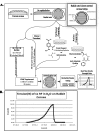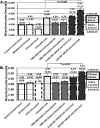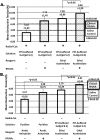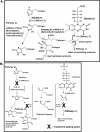Mechanisms of corneal tissue cross-linking in response to treatment with topical riboflavin and long-wavelength ultraviolet radiation (UVA)
- PMID: 19643975
- PMCID: PMC2869064
- DOI: 10.1167/iovs.09-3738
Mechanisms of corneal tissue cross-linking in response to treatment with topical riboflavin and long-wavelength ultraviolet radiation (UVA)
Abstract
Purpose: Treatment of de-epithelialized human corneas with riboflavin (RF) + long-wavelength ultraviolet light (UVA; RFUVA) increases corneal stroma tensile strength significantly. RFUVA treatment retards the progression of keratoconus, perhaps by cross-linking of collagen molecules, but exact molecular mechanisms remain unknown. Research described here tested possible chemical mechanisms of cross-linking.
Methods: Corneas of rabbits and spiny dogfish sharks were de-epithelialized mechanically, subjected to various chemical pretreatments, exposed to RFUVA, and then subjected to destructive tensile stress measurements. Tensile strength was quantified with a digital force gauge to measure degree of tissue cross-linking.
Results: For both rabbit and shark corneas, RFUVA treatment causes significant cross-linking by mechanism(s) that can be blocked by the presence of sodium azide. Conversely, such cross-linking is greatly enhanced in the presence of deuterium oxide (D(2)O), even when RF is present at only one tenth the currently used clinical concentrations. Blocking carbonyl groups preexisting in the stroma with 2,4-dinitrophenylhydrazide or hydroxylamine blocks essentially all corneal cross-linking. In contrast, blocking free amine groups preexisting in the stroma with acetic anhydride or ethyl acetimidate does not affect RFUVA corneal cross-linking. When both carbonyl groups are blocked and singlet oxygen is quenched, no RFUVA cross-linking occurs, indicating the absence of other cross-linking mechanisms.
Conclusions: RFUVA catalyzes cross-linking reactions that require production of singlet oxygen ((1)O(2)), whose half-life is extended by D(2)O. Carbonyl-based cross-linking reactions dominate in the corneal stroma, but other possible reaction schemes are proposed. The use of D(2)O as solution media for RF would enable concentration decreases or significant strength enhancement in treated corneas.
Figures








References
-
- Wollensak G, Spoerl E, Seiler T. Riboflavin/ultraviolet-A-induced collagen crosslinking for the treatment of keratoconus. Am J Ophthalmol 2003; 135: 620–627 - PubMed
-
- Wollensak G. Crosslinking treatment of progressive keratoconus: new hope. Curr Opin Ophthalmol 2006; 17: 356–360 - PubMed
-
- Caporossi A, Baiocchi S, Mazzotta C, Traversi C, Caporossi T. Parasurgical therapy for keratoconus by riboflavin-ultraviolet type A rays induced cross-linking of corneal collagen: preliminary refractive results in an Italian study. J Cataract Refract Surg 2006; 32: 837–845 - PubMed
-
- Wollensak G, Spoerl E, Seiler T. Stress-strain measurements of human and porcine corneas after riboflavin-ultraviolet-A-induced cross-linking. J Cataract Refract Surg 2003; 29: 1780–1785 - PubMed
-
- Seiler T, Hafezi F. Corneal cross-linking-induced stromal demarcation line. Cornea 2006; 25: 1057–1059 - PubMed
Publication types
MeSH terms
Substances
Grants and funding
LinkOut - more resources
Full Text Sources
Other Literature Sources

